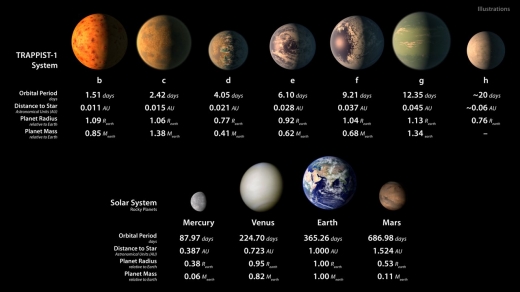Centauri Dreams
Imagining and Planning Interstellar Exploration
‘Dust Traps’ and Planet Formation
Are we homing in on a ‘missing link’ in our theories of planet formation? Perhaps so, judging from the work of researchers at Swinburne University of Technology, Lyon University and St. Andrews University. The work does not challenge a central principle in current thinking, that planets form out of disks of gas and dust grains around young stars. We know that these dust grains grow into centimeter-sized aggregates. We also know that, much later, planetesimals (kilometers in size) grow into planetary cores.
What has been missing is an understanding of how the early ‘pebbles’ are able to aggregate into asteroid-sized objects. One problem is that drag in the disk produced by surrounding gas makes the grains move inward toward the star, a movement that can deplete the disk. The paper describes this as a ‘radial drift barrier,’ in which the grains settle to the midplane of the disk and drift inwards as they lose angular momentum. Taken to its conclusion, the process can lead to accretion into the star, preventing disk grains from ever forming planetesimals.
The second issue: Larger dust grains with higher relative velocities can experience collisions that make aggregation impossible. This is the so-called ‘fragmentation barrier,’ where dust grains shatter instead of sticking after collisions.
How, then, do planets actually form? The researchers have created simulations developing a theory involving ‘dust traps,’ high-pressure locations in the disk where dust grains accumulate as drift motion slows. The accumulation of growing and fragmented grains interacts with circumstellar gas to create these areas, in which trapped particles can grow. At reduced speeds within the traps, the grains avoid fragmentation. The process is depicted in the image below.
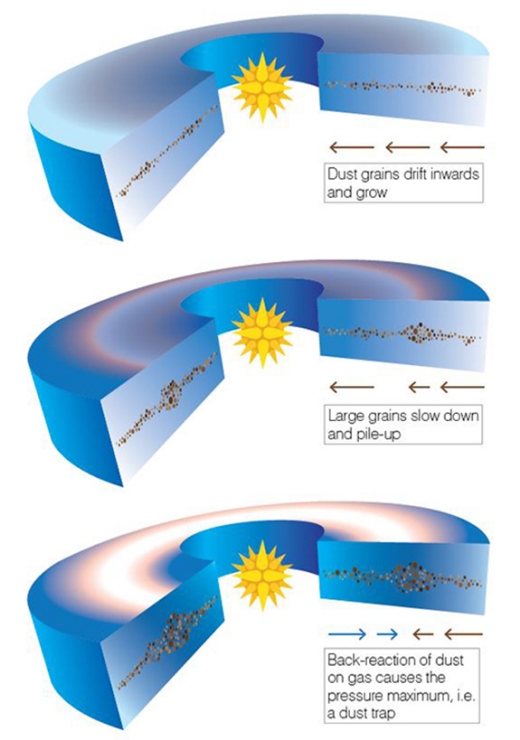
Image: The stages of the formation of dust traps. The central (yellow) star, surrounded by the protoplanetary (blue) disk. The dust grains make up the band running through the disk. Credit: © Volker Schubert.
Thus dust grains modify the structure of the surrounding gas. Sarah Maddison (Swinburne University) explains:
“What we have been able to identify is the key role of the drag of dust on the gas. Often in astronomy, the gas tells the dust how to move, but when there is a lot of dust, the dust tells the gas how to move. This effect, known as aerodynamic drag back-reaction, is usually negligible. However, the effect becomes important in dust rich environments, like those found in the planet formation process.”
Back-reaction, in other words, slows the drift of dust grains inward toward the star, giving them time to grow in size to the point where drag from the gas no longer determines their fate. The gas is pushed outwards to form the high pressure region the team calls a dust trap. Concentrated dust grains in the dust traps then spark the subsequent formation of planets.
The process functions in the team’s simulations for a wide range of initial disk structures and dust to gas ratios. From the paper:
We demonstrate that this process is extremely robust and that self-induced dust traps form in different disc structures, with different fragmentation thresholds, and for a variety of initial dust-to-gas ratios. Changing these parameters result in self-induced dust traps at different locations in the disc, and at different evolutionary times.
The process, then, should be widespread despite differences in the stellar environment. The key thing is that the formation of the dust traps makes subsequent planet formation possible. How the fragmentation of dust grains operates determines the result:
While seemingly counter-intuitive, fragmentation is a vital ingredient for planet formation as it helps to form dust traps at large distances from the star. Indeed, fragmentation only allows grains to grow exterior to a certain radial distance and when grains decouple from the gas and start piling up, they do so near that radius. Stronger fragmentation, with a lower fragmentation threshold, implies that this radius lies farther away from the star. This would suggest that most discs thus retain and concentrate their grains at specific locations in time-scales compatible with recent observations of structures in young stellar objects.
The researchers have found a way to overcome the planetary formation bottleneck, allowing micrometer-sized dust grains to grow to centimeter-size and above, forming the structures that will eventually be incorporated into planetesimals. The process of going from planetesimal to planet, the researchers argue, has been considered through various mechanisms, but the missing piece has always been the preservation of the original dust grains in the disk long enough for aggregation to occur before their accretion into the star. Here, at least, we have a theoretical mechanism to explain how the grains are preserved and can grow.
The paper is Gonzalez, Laibe & Maddison, “Self-induced dust traps: overcoming planet formation barriers,” Monthly Notices of the Royal Astronomical Society 467 (2) (2017), pp. 1984-1996 (abstract / preprint).

Planet Formation inside a Circumbinary ‘Snowline’
The binary system SDSS 1557, about 1000 light years from Earth, was thought to be a single white dwarf star until detailed measurements revealed that the brighter star was being gravitationally influenced by a hither unseen brown dwarf. And that, in turn, has given us an intriguing look at possible planetary formation around both members of a close binary. We’ve found gas giants in such systems, but researchers led by Jay Farihi (University College London) have found signs of rocky debris here that point to the possibility of planets of a much different composition.
“Building rocky planets around two suns is a challenge,” says Farihi, “because the gravity of both stars can push and pull tremendously, preventing bits of rock and dust from sticking together and growing into full-fledged planets. With the discovery of asteroid debris in the SDSS 1557 system, we see clear signatures of rocky planet assembly via large asteroids that formed, helping us understand how rocky exoplanets are made in double star systems.”
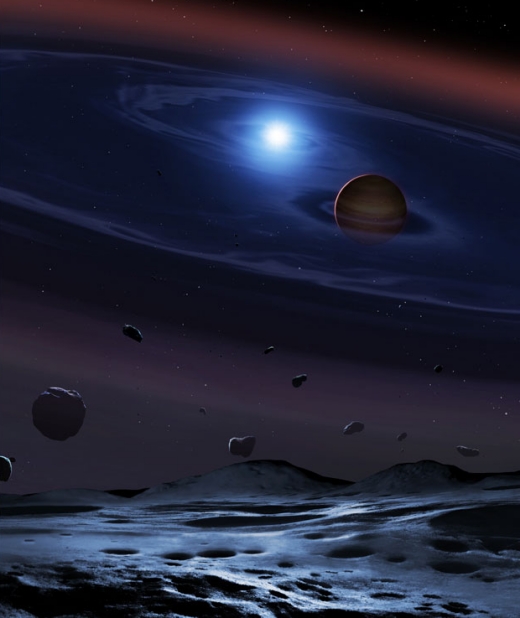
Image: A disc of rocky debris from a disrupted planetesimal surrounds white dwarf plus brown dwarf binary star. The white dwarf is the burned-out core of a star that was probably similar to the Sun, the brown dwarf is only ~60 times heavier than Jupiter, and the two stars go around each other in only a bit over two hours. Credit: Mark Garlick, UCL, University of Warwick and University of Sheffield.
Can planets, or at least their debris, survive the red giant expansion phase that leads to a white dwarf? Yes, says the new paper on this work, noting that we now have more than three dozen planetary system remnants that have been found through study of circumstellar disks of white dwarfs; we also have several hundred white dwarfs that show signs of accretion of planetary debris.
The debris around SDSS 1557 is spread around the two stars, offering a helpful target for the team’s analysis. Working with observations from the Gemini Observatory South instrument and the European Southern Observatory’s Very Large Telescope, the team found material with high metal content including silicon and magnesium, which could be identified as it was drawn onto the surface of the white dwarf. Such atmospheric pollution has become a tool for the analysis of white dwarf systems. In this case, the UCL team found that 1017 grams of matter — the equivalent of a 4 km asteroid — produced the observed result.
The paper on this work points out that planets of Neptune up to Jupiter size are unlikely to form where they have been found in Kepler detections of circumbinary planets, but are likely the result of migration. However, models exist for smaller planet formation within the snowline, which gives us the possibility of planets like the famous ‘Tatooine,’ from George Lucas’ Star Wars. And work on polluted white dwarfs adds weight to the idea.
From the paper:
The current paradigm of disrupted and accreted asteroids has been unequivocally confirmed by numerous studies, including the recent detection of complex and rapidly evolving photometric transits from debris fragments orbiting near the Roche limit of one star. To date, all polluted white dwarfs with detailed analyses indicate the sources are rocky planetesimals comparable in both mass and composition to large Solar System asteroids, and thus objects that formed within a snow line. These findings unambiguously demonstrate that large planetesimal formation in the terrestrial zone of stars is robust and common.

Dr. Farihi is on record (on his homepage) as saying that he believes we will learn more about extrasolar terrestrial planets using white dwarfs than any other method. The reason: The atmospheres of cool white dwarfs feature hydrogen and helium that can easily become polluted by small amounts of heavy elements. Work like the current paper reminds us that we can use this metal pollution to measure the composition of rocky material around the star.
The debris responsible for white dwarf atmospheric pollution is believed to come from tidally destroyed asteroids whose parent bodies were large and differentiated. Farihi notes that we may be looking at the parent bodies of planetesimals or even fragments of major planets, with compositions similar to material found in our own inner Solar System. He estimates that 20% to 30% of all white dwarfs are orbited by the remains of terrestrial planetary systems.
Image: Dr. Jay Farihi, among some exceedingly interesting standing stones. Credit: Jay Farihi/UCL.
The SDSS 1557 discovery calls for continuing follow-ups, for as co-author Boris Gänsicke (University of Warwick) points out, the signature is transient. Says Gänsicke:
“Any metals we see in the white dwarf will disappear within a few weeks, and sink down into the interior, unless the debris is continuously flowing onto the star. We’ll be looking at SDSS 1557 next with Hubble, to conclusively show the dust is made of rock rather than ice.”
So at SDSS 1557 we have all the markers of a parent body that formed within the snowline, which implies that rocky planet formation in circumbinary orbits within a close double system is feasible. The paper concludes: “These observations therefore support a picture where additional mechanisms can promote planetesimal growth in the terrestrial zones of close binary stars, which are predicted to be substantially wider than in planet forming disks around single stars.”
The paper is Farihi, Parsons & Gänsicke, “A circumbinary debris disk in a polluted white dwarf system,” Nature Astronomy 1 March 2017 (abstract / preprint).

A Volcanic View of the Habitable Zone
Our understanding of habitable zones is a work in progress, but the detection of multiple planets with potentially water-bearing surfaces around TRAPPIST-1 is heartening. Today we examine the prospect of extending the habitable zone further out from the host star than previously thought possible. The idea is found in new work by Ramses Ramirez and Lisa Kaltenegger (both at the Carl Sagan Institute at Cornell University). Volcanism is the key, allowing interactive effects that pump up greenhouse warming and sustain habitability.

Go back for a moment to the habitable zone limits that Andrew LePage looked at yesterday in his analysis of TRAPPIST-1. The classical habitable zone — allowing liquid water to exist on the surface — has an inner edge at which surface temperatures become high enough to lead to a runaway greenhouse and the rapid loss of water. The outer edge is defined by the distance beyond which CO2 can no longer produce the needed greenhouse effect to keep the surface warm.
Image: Ramses Ramirez, research associate at Cornell’s Carl Sagan Institute, left, and Lisa Kaltenegger, professor of astronomy and director of the Sagan Institute. Credit: Carl Sagan Institute.
But consider, say Ramirez and Kaltenegger, the effect of additional greenhouse gases on these worlds at the outer edge of the HZ. Here’s some context: The warming effect of hydrogen atmospheres has already been considered on young planets, allowing a primordial super-Earth to stay above freezing at the surface out to distances in the range of 10 AU. The paper explains that this greenhouse effect comes from what is known as collision-induced absorption, the result of so-called ‘self-broadening’ when H2 molecules collide.
The problem: Primordial hydrogen in the large amounts needed isn’t sustainable over geological timescales, meaning a super-Earth without a renewable hydrogen source would lose hydrogen to space. But volcanism can be the renewable source needed. The authors point out that climate studies of the early Earth and Mars both show that volcanism could have outpaced the escape of H2. Hydrogen here is not a major atmospheric constituent but is continually replenished by volcanism that offsets H2 loss.
Now we are in a situation where any atmospheric CO2 can interact with hydrogen to increase the greenhouse warming potential for the planet over long time periods. The effect could extend a habitable zone by between 30 and 60 percent. Says Ramirez:
“On frozen planets, any potential life would be buried under layers of ice, which would make it really hard to spot with telescopes. But if the surface is warm enough – thanks to volcanic hydrogen and atmospheric warming – you could have life on the surface, generating a slew of detectable signatures.”

Image: The eruption of the Tavurvur volcano in Papua New Guinea, part of the Rabaul Caldera on New Britain. Can similar eruptions produce the factors needed for habitability at the outer edge of the habitable zone? Credit: Taro Taylor edit by Richard Bartz – originally posted to Flickr as End Of Days, CC BY 2.0.
In terms of our own Solar System, the researchers point out that the addition of 30% H2 can extend the habitable zone to 2.4 AU, putting its outer edge in the main asteroid belt (the habitable zone around Sol is normally considered to extend to 1.67 AU, just beyond the orbit of Mars). Because we’ll be looking for atmospheric biosignatures with upcoming instruments like the James Webb Space Telescope and the European Extremely Large Telescope, we’ll want to factor this extended habitable zone into our list of search candidates.
In their paper, which appears in The Astrophysical Journal Letters, the researchers use climate models to compute the boundaries of what they are calling the ‘volcanic hydrogen habitable zone’ for concentrations of hydrogen between 1% and 50% — finding that at a hydrogen concentration at the upper end of that range, the effective stellar flux needed to support the outer edge of the habitable zone decreases by ~35% to 60%, with the corresponding orbital distances to remain habitable increasing by 30% to 60%. The effective temperatures (TEFF of the stars examined range from 2,600K to 10,000K — the stellar classes range from M dwarfs to A-type main sequence stars.
Given these prospects, how do we go about searching for life signatures on outer planets with sizeable amounts of atmospheric hydrogen? It’s a vexing question:
Certain atmospheric spectral features, including N2O and NH3, which can, but do not have to be produced biotically, could be detected in H2 -dominated atmospheres (Seager et al., 2013; Baines et al., 2014). Such volcanic-hydrogen atmospheres may also be able to evolve methane-based photosynthesis (Bains et al., 2014). Distinguishing biosignatures from abiotic sources in such atmospheres will be challenging.
Note the possibilities that must be distinguished here:
NH3 can be formed abiotically through reaction of N2 and H2 in hydrothermal vents on planets with reducing mantles (Kasting et al., 2014). N2O can be formed a number of ways including through atmospheric shock from meteoritic fall-in, lightning, UV radiation (e.g. Ramirez, 2016) and through solar flare interactions with the magnetosphere (Airapetian et al., 2016). Thus, future biosignature studies should focus on modeling biotic and abiotic sources for these gases in thin volcanic-hydrogen atmospheres.
Clearly there is plenty of work ahead, but a combined greenhouse effect from hydrogen, water and CO2 could be the key to expand stellar habitable zones and widen our observational window. As Kaltenegger puts it, “Where we thought you would only find icy wastelands, planets can be nice and warm – as long as volcanoes are in view.” And warming hydrogen, all too easily lost into space, can be renewed by the same kind of volcanic hydrogen that puffs up planetary atmospheres, making that much stronger a signal for the detection of biomarkers.
Does TRAPPIST-1, then, have the capacity for yet another planet in the habitable zone? Kaltenegger isn’t ready to go that far, saying “…uncertainties with the orbit of the outermost Trappist-1 planet ‘h’ mean that we’ll have to wait and see on that one,”
The paper is Ramirez and Kaltenegger, “A Volcanic Hydrogen Habitable Zone,” The Astrophysical Journal Letters 837, No. 1 (2017). Abstract available.

The (Potentially) Habitable Worlds of TRAPPIST-1
When the news about the seven planets of TRAPPIST-1 broke, I immediately wondered what Andrew LePage’s take on habitability would be. A physicist and writer with numerous online essays and a host of articles in magazines like Scientific American and Sky & Telescope, LePage is also a specialist in the processing and analysis of remote sensing data. He has put this background in data analytics to frequent use in his highly regarded ‘habitable planet reality checks,’ which can be found on his Drew ex Machina site. Having run a thorough analysis of the TRAPPIST-1 situation the other day, Drew now gives us the gist of his findings, which move at least several of the TRAPPIST-1 planets into a potentially interesting category indeed.
By Andrew LePage

Like so many other people interested in exoplanets, I made it a point to watch NASA’s press conference live on February 22. Based on the list of participants released by NASA a couple of days earlier, a number of people (myself included) suspected that this was going to be an announcement about new findings of the TRAPPIST-1 planetary system. Back in May of 2016, a team of scientists led by Michaël Gillon (University of Liège – Belgium) had announced the discovery of three Earth-size exoplanets orbiting TRAPPIST-1 – a very small red dwarf star known as an ultracool dwarf named after ESO’s ground-based TRAPPIST (TRAnsiting Planets and PlanetesImals Small Telescope) telescope which had spotted the transits of these exoplanets during an observing campaign in 2015. This star and its system of transiting planets was a natural target for follow up observations by ground and space-based instruments.
As it turned out, NASA’s press conference did involve an announcement of the results of new observations of TRAPPIST-1. A total of 1,333 hours of new photometry including 518 hours of data from NASA’s Spitzer Space Telescope had been acquired since the original discovery paper about TRAPPIST-1 had been submitted by Gillon et al.. Most helpful of all was a virtually uninterrupted 20-day observation run by Spitzer from September 19 to October 10, 2016 which allowed a thorough evaluation of the system. In the end, Gillon et al. had identified the transits of a total of seven exoplanets orbiting TRAPPIST-1 – the largest number of exoplanets found so far orbiting a star. Most exciting of all was the claim that three of these Earth-size exoplanets were potentially habitable.
As my published work over the past couple of decades can testify, I am a long-time believer that the galaxy is filled with habitable planets (and moons!). However, I have also been quite skeptical of frequently dubious claims made by some in recent years that various new exoplanetary discoveries are potentially habitable. Back in May 2016 when Gillon et al. originally announced the discovery of the first three exoplanets found orbiting TRAPPIST-1, the ESO press release and other sources claimed that they were all potentially habitable. My published review of the data available at the time showed no support for this claim: two of the new exoplanets were much more likely to be slightly larger and hotter versions of Venus while the orbit of the third exoplanet was so poorly constrained that nothing meaningful could be said yet about its potential habitability. Naturally I was quite skeptical about this new claim being made by some of the same scientists about TRAPPIST-1. With a copy of the new discovery paper by Gillion et al. in hand along with other peer-reviewed papers on this system published in recent months, I performed a fresh review of the potential habitability of the exoplanets in this system.
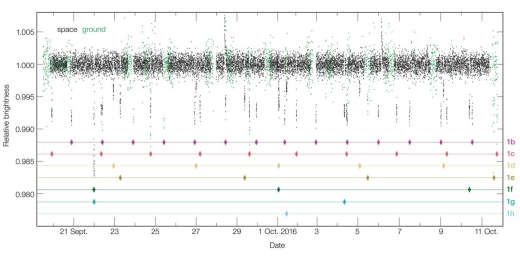
Image: This diagram shows the changing brightness of TRAPPIST-1 over a period of 20 days in September and October 2016 as measured by NASA’s Spitzer Space Telescope and various ground instruments. The dips in brightness caused by transiting exoplanets are clearly seen. (ESO/M. Gillon et al.)
Definition of the Habitable Zone
A thorough assessment of the habitability of any extrasolar planet would require a lot of detailed data on the properties of that planet, its atmosphere, its spin state and so on. Unfortunately, at this very early stage, the only information typically available to scientists about extrasolar planets is basic orbit parameters, a rough measure of its size and/or mass and some important properties of its sun. Combined with theoretical extrapolations of the factors that have kept the Earth habitable over billions of years (not to mention why our neighbors are not), the best we can hope to do at this time is to compare the known properties of extrasolar planets to our current understanding of planetary habitability to determine if an extrasolar planet is “potentially habitable”. And by “habitable”, I mean in an Earth-like sense where the surface conditions allow for the existence of liquid water on the planet’s surface – one of the presumed prerequisites for the development of life as we know it. While there may be other worlds that might possess environments that could support life, these would not be Earth-like habitable worlds of the sort being considered here.
One of the important criteria which we can use to determine if a planet is potentially habitable is the amount of energy it receives from its sun known as the effective stellar flux or Seff. According to the work by Ravi Kopparapu (Penn State) and his collaborators on the limits of the habitable zone (HZ) based on detailed climate and geophysical modeling, the outer limit of the HZ is conservatively defined as corresponding to the maximum greenhouse limit of a CO2-rich atmosphere where the addition of any more of this greenhouse gas would not increase a planet’s surface temperature any further. For a star like TRAPPIST-1 with a surface temperature of 2559 K, this conservative outer limit for the HZ as defined by Kopparapu et al. (2013, 2014) has an Seff of 0.22 corresponding to a orbital semimajor axis of 0.048 AU. This Seff value for the outer limit of the HZ is lower than the 0.36 for a planet orbiting a more Sun-like star because ultracool dwarf stars emit so much of their energy in the infrared part of the spectrum where atmospheric absorption is important.
The inner limit of the HZ is conservatively defined by Kopparapu et al. (2013, 2014) by the runaway greenhouse limit where a planet’s temperature would soar even with no CO2 present and lose all of its water in a geologically brief time in the process. For an Earth-size planet orbiting TRAPPIST-1, this happens at an Seff value of 0.91 which corresponds to a distance of 0.024 AU. Once again, this Seff value for the inner edge of the HZ is lower than the 1.11 for a Sun-like star because TRAPPIST-1 radiates so much of its energy in the infrared.
Because of the tight orbits of these exoplanets and the constraints placed on their eccentricity, it is likely that they are synchronous rotators with the same side perpetually facing their sun. Detailed climate modeling over the last two decades now shows that synchronous rotation is probably not the impediment to habitability as it was once thought. In fact, it has been shown that slow or synchronous rotation can actually result in an increase of the Seff for the inner edge of the HZ. According to the recent work by Jun Yang (University of Chicago) and collaborators, the inner edge of the HZ for a slow rotator orbiting a star like TRAPPIST-1 would have an Seff of 1.44 corresponding to an orbital distance of just 0.019 AU.
Image: This diagram shows a comparison of the properties of the newly discovered planets of TRAPPIST-1 with the inner planets of our solar system. (NASA)
The Exoplanets of TRAPPIST-1
The first two exoplanets in this system, TRAPPIST-1b and c, have radii of 1.09 RE (or Earth radii) and 1.06 RE, respectively. While it was claimed back in May 2016 that these two exoplanets were potentially habitable, their Seff values of 4.3 and 2.3 are higher than the 1.9 value for Venus, which is most definitely not a habitable planet. With their Venus-like sizes, Venus-like rotation states and Seff values in excess of Venus’, these are most likely to be non-habitable, Venus-like worlds contrary to the original claims made in May 2016. Fortunately, Gillon et al. have now adopted the more conservative definition of the HZ of Kopparapu et al. (2014, 2014) so this dubious claim was not repeated in the new discovery paper.
As we move outward from the parent star of this system, things begin to become a bit more interesting. What is now designated TRAPPIST-1d has a radius of 0.77 RE which is intermediate between Earth and Mars in size and is therefore likely to be a rocky planet. With an Seff of 1.14, TRAPPIST-1d would seem to be comfortably inside the HZ for a slow rotator as defined by Yang et al.. However, as Gillon et al. mention in their new paper, more recent work by Kopparapu et al. (2016) has shown that Coriolis effects for synchronous rotators with short orbital periods will alter the global circulation pattern in a way which affects cloud formation on the dayside – clouds which help to reflect away much of the energy the planet receives from its sun moderating the surface temperature in the process. With an orbital period (and presumably a period of rotation) of just four days, TRAPPIST-1d is probably rotating too quickly to maintain sufficient cloud cover on its dayside to keep from experiencing a runaway greenhouse effect. While it is certainly worthy of continued detailed study, it would seem that the chances that TRAPPIST-1d is potentially habitable are not very promising and Gillon et al. do not categorize this new find of theirs in that way.
The situation with TRAPPIST-1e is substantially better and it has been identified in the new work by Gillon et al. as being potentially habitable. With an Seff of 0.66, this exoplanet is comfortably inside the conservatively defined HZ of TRAPPIST-1. With a radius of 0.91 RE, it is only slightly smaller than Earth and is not expected to be a volatile-rich mini-Neptune with poor prospects of being habitable. If it were not for the still unresolved issues associated with orbiting so close to an ultracool dwarf and how that affects the volatile inventories of such worlds, TRAPPIST-1e could be considered one of the best candidates currently known for being a potentially habitable exoplanet. Undoubtedly, detailed climate modeling of this exoplanet will help to determine the range of water and other volatile content values which could yield a habitable world much as is being done for our Earth-size neighbor, Proxima Centauri b, as well as the growing list of other potentially habitable red dwarf exoplanets.
The next planet out, TRAPPIST-1f, was also identified as being potentially habitable in the new work by Gillon et al.. Its Seff value of 0.38 is comparable to that of Mars but, since so much of the energy emitted by TRAPPIST-1 is in the infrared, it is still comfortably inside the conservatively defined HZ for this star. While the radius of 1.05 RE would suggest that TRAPPIST-1f is a rocky world like the Earth, other data hint otherwise and raises some possible problems.
Because of the packed nature of this planetary system with its orbits near resonance, it is expected that they would strongly interact with each other gravitationally producing variations in their transit timings. Gillon et al. performed an analysis of these transit timing variations (TTV) derived from all of their photometry data and found them to be on the order of tens of seconds to more than a half an hour – more than sufficient to estimate the masses of the inner six planets. Unfortunately, the uncertainties associated with current TTV-derived mass values are still rather large while the calculated densities (which can be used to help constrain the bulk compositions of these exoplanets) are even more uncertain still. What can be said is that all of these exoplanets are approximately Earth-mass (or ME) objects. The calculated densities with their large uncertainties are also not inconsistent with a rocky composition… the one exception being TRAPPIST-1f.
TRAPPIST-1f has a TTV-derived mass of 0.68±0.18 ME – the most accurately known mass in this system so far. This yields a density that is 0.60±0.17 times that of Earth’s which is suggestive of a volatile-rich bulk composition. It could be that TRAPPIST-1f is a mini-Neptune with a deep hydrogen-rich atmosphere overlaying layers of high temperature/pressure phases of ice rendering it non-habitable. It might also be more of an ocean planet with a CO2-rich atmosphere a few times denser than the Earth’s capping a deep ocean of liquid water. Hubble observations might help to eliminate the former possibility by searching for hydrogen in an extended atmosphere although observations by JWST and other future instruments will be required to begin to explore the latter possibility.
But before too much is read into the apparent low density of this exoplanet, it should be remembered that TTV-derived masses are notorious for changing by rather large amounts as new data become available. NASA’s Kepler spacecraft is currently wrapping up Campaign 12 of its extended K2 mission where it observed a star field which includes TRAPPIST-1. With a virtually continuous photometric data set running from December 15, 2016 to March 4, 2017, it should be possible to calculate more accurate TTV-derived masses in the coming months.
It may turn out that the uncertainties in the mass and density of TRAPPIST-1f have been underestimated and it is actually a denser rocky world like the Earth. But even if the low density of TRAPPIST-1f is confirmed and it is unlikely to be potentially habitable, it nevertheless strongly suggests that small planets orbiting ultracool dwarfs can retain substantial amounts of their water and other volatiles contrary to some of the less optimistic predictions that have been made. This would markedly improve the habitability prospects of many red dwarf planets. For now, TRAPPIST-1f is a reasonable candidate for being potentially habitable – definitely better than TRAPPIST-1d but maybe not as good as e.
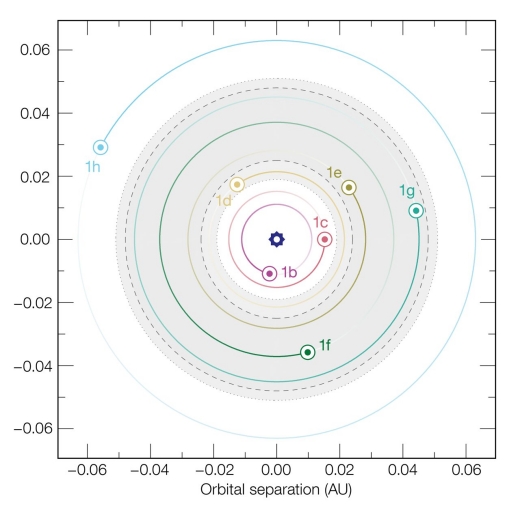
Image: This diagram shows the relative sizes of the orbits of the seven planets orbiting TRAPPIST-1. The shaded area shows the extent of the habitable zone (HZ) with alternative boundaries indicated by dashed lines. (ESO/M. Gillon et al.).
The last of their discoveries identified by Gillon et al. as being potentially habitable is TRAPPIST-1g. With a radius of 1.12 RE, it is unlikely to be a mini-Neptune but its currently ill-defined density as well as the fact that the smaller and closer TRAPPIST-1f may be volatile-rich makes it impossible to exclude the possibility. With a Seff of 0.26, TRAPPIST-1g is towards the outer edge but still comfortably inside the HZ for such a cool star. Once again, the claim made by Gillon et al. that this is a potentially habitable exoplanet it a reasonable one given what we currently know about this world. The final planet in this system, TRAPPIST-1h, still has an ill-defined orbit but it seems likely that it is outside of the HZ.
Summary
Contrary to my initial reservations, it does appear that the claim that the TRAPPIST-1 system contains three potentially habitable exoplanets has merit given what we currently know about them. There are obviously unresolved issues about how much of their original volatile inventories these exoplanets have managed to retain despite the higher luminosity of their parent star during its earliest history as well as its subsequent bouts of chromospheric activity like flares not to mention the relatively high flux of X-ray and extreme ultraviolet radiation that have already been observed. While losses of volatiles are expected, it is still not known with any certainty how this will ultimately affect the habitability of these and a growing list of similar red dwarf exoplanets. The fact that the initial TTV analysis of this system implies that TRAPPIST-1f has a volatile-rich bulk composition is a hopeful sign that exoplanets in the HZ of small red dwarfs can retain their volatiles, which improves the habitability prospects of such worlds.
Fortunately, TRAPPIST-1 with its seven transiting, Earth-size exoplanets is an ideal laboratory for exploring the question of how such worlds evolve and whether they can be habitable. New observations from NASA’s Hubble Space Telescope are already working their way through the peer-review process which may help constrain the properties of these exoplanets. We should also expect an analysis of the new Kepler data to provide more information in the next few months on the properties of these exoplanets especially better TTV-derived mass (and density) estimates. It is also possible that additional exoplanets will be found orbiting TRAPPIST-1, although it is unlikely that more will be found in the already tightly packed HZ. The commissioning of NASA’s James Webb Space Telescope and other instruments in the years to come also promises to shed much light on the properties of these exoplanets and their potential habitability. The excitement generated by these new finds is definitely well deserved.
A more detailed discussion of the history of TRAPPIST-1 observations, the properties of its exoplanets and their potential habitability can be found at “Habitable Planet Reality Check: The Seven Planets of TRAPPIST-1” (http://www.drewexmachina.com/2017/02/25/habitable-planet-reality-check-the-seven-planets-of-trappist-1/).
Selected References
Michaël Gillon et al., “Temperate Earth-sized Planets Transiting a Nearby Ultracool Dwarf Star”, Nature, Vol. 533, pp. 221-224, May 12, 2016
Michaël Gillon et al., “Seven temperate terrestrial planets around the nearby ultracool dwarf star TRAPPIST-1”, Nature, Vol 542., pp. 456-460, February 23, 2017 (preprint of paper is available from the ESO at http://www.eso.org/public/archives/releases/sciencepapers/eso1706/eso1706a.pdf)
R.K. Kopparapu et al., “Habitable zones around main-sequence stars: new estimates”, The Astrophysical Journal, Vol. 765, No. 2, Article ID. 131, March 10, 2013
Ravi Kumar Kopparapu et al., “Habitable zones around main-sequence stars: dependence on planetary mass”, The Astrophysical Journal Letters, Vol. 787, No. 2, Article ID. L29, June 1, 2014
Ravi Kumar Kopparapu et al., “The Inner Edge of the Habitable Zone for Synchronously Rotating Planets around Low-mass Stars Using General Circulation Models”, The Astrophysical Journal, Vol. 819, No. 1, Article ID. 84, March 2016
Jun Yang et al., “Strong Dependence of the Inner Edge of the Habitable Zone on Planetary Rotation Rate”, The Astrophysical Journal Letters, Vol. 787, No. 1, Article id. L2, May 2014

SPECULOOS: Nearby Red Dwarfs
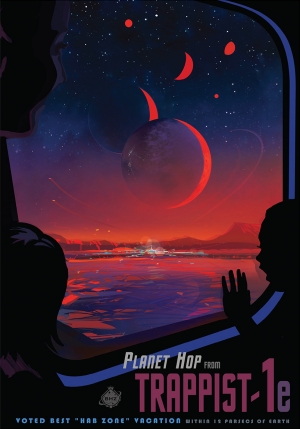
Let’s turn the clock back a bit on the TRAPPIST-1 discoveries with a reminder of Hubble work on this system announced last July. A team led by Julien de Wit (MIT) used the Hubble Space Telescope’s Wide Field Camera 3 to look for atmospheres on TRAPPIST-1b and 1c, two of the three planets then known around this star. The researchers were able to take advantage of a rare simultaneous transit, when both planets crossed the star within minutes of each other, an event that has been calculated to occur only every two years.
The result: No sign of the kind of hydrogen-dominated atmospheres we would expect on gaseous worlds. That was good news, for reasons that Nikole Lewis (Space Telescope Science Institute) explained:
“The lack of a smothering hydrogen-helium envelope increases the chances for habitability on these planets. If they had a significant hydrogen-helium envelope, there is no chance that either one of them could potentially support life because the dense atmosphere would act like a greenhouse.”
Image: NASA’s latest exoplanet ‘travel poster.’ From the JPL caption: “Some 40 light-years from Earth, a planet called TRAPPIST-1e offers a heart-stopping view: brilliant objects in a red sky, looming like larger and smaller versions of our own moon. But these are no moons. They are other Earth-sized planets in a spectacular planetary system outside our own. These seven rocky worlds huddle around their small, dim, red star, like a family around a campfire.” The poster can be downloaded here. Credit: NASA-JPL/Caltech.
This was, of course, before we knew there were seven planets in this system, but it was clear at the time that future observations would be needed to tell us what kind of atmospheres these worlds had, if any, and what their surface conditions might be. The paper in Nature also noted the need for spectroscopic analysis to look for methane or water features, all part of estimating the depth of any atmospheres on the two worlds.
I hark back to this story because we’re proceeding with exactly the kind of focused work the de Wit team was calling for in the summer of 2016. For it turns out that the discovery of TRAPPIST-1’s first three planets, and the four subsequent ones, was part of a larger project called the Search for habitable Planets EClipsing ULtra-cOOl Stars (SPECULOOS), whose goal is to search for planets in the habitable zones of the nearest 500 ultracool stars and brown dwarfs.
Its acronym created as a nod to a Flemish spiced shortbread, SPECULOOS is in the early stages of its work. At the European Southern Observatory’s Paranal Observatory in Chile, four robotic telescopes make up the observing infrastructure, each of them housing a one-meter primary mirror and cameras sensitive in the near-infrared. The project involves scientists from the University of Liège (Belgium) as well as other universities, and is under the leadership of Michaël Gillon, who has led the TRAPPIST-1 planetary discovery effort.
Thus the TRAPPIST effort (TRAnsiting Planets and PlanetesImals Small Telescopes) is actually folded into the larger SPECULOOS survey, as is a second ESO effort at Oukaïmden Observatory in Morocco. But SPECULOOS is designed to survey ten times as many red dwarfs as TRAPPIST does, and according to this ESO news release, it is expected to discover a number of systems similar to TRAPPIST-1, at least in terms of the number of planets involved, if perhaps not as fortuitously angled to give us seven transits.
Thus the Hubble work of 2016 can be placed within a larger context, the ongoing effort to survey nearby red dwarfs and brown dwarfs and determine which of these are most suitable for studying their atmospheres. By examining the mass, radius and orbital parameters of such worlds and analyzing possible atmospheres, SPECULOOS will feed future observatories like the James Webb Space Telescope and the 39-meter European Extremely Large Telescope with the target list they need.
The excitement of this ‘golden age’ of exoplanet discovery can only build as we realize that these upcoming observatories, along with missions like TESS (Transiting Exoplanet Survey Satellite) and CHEOPS (CHaracterising ExOPlanets Satellite) are not that far in the future (TESS is scheduled for launch in 2018, and CHEOPS should be ready for launch by then). Having made a statistical analysis of the broad exoplanet population with Kepler, we now turn to stars closer to home, and the possibility of finding biomarkers in their atmospheres.

Image: Planets in a compact red dwarf system. Credit: ESO.
In addition to the paper on TRAPPIST-1’s seven planets cited yesterday, I also want to cite the de Wit et al. paper referenced above, “A combined transmission spectrum of the Earth-sized exoplanets TRAPPIST-1 b and c ‘,” Nature 537, (01 September 2016), 69-72 (abstract) and Gillon et al., “Temperate Earth-sized planets transiting a nearby ultramool dwarf star,” Nature 533 (12 May 2016), 221-224 (abstract).

Further Thoughts on TRAPPIST-1
In yesterday’s news conference on the seven planets around TRAPPIST-1, exoplanet scientist Sara Seager (MIT) pointed to the discovery as accelerating our search for habitable worlds. “Goldilocks,” Seager said in a finely chosen turn of phrase, “has many sisters in this system.” I think she’s exactly correct, even though we don’t yet know if any of these particular worlds house life. For as Seager went on to point out, we now need to study the atmospheres of these planets to find out what’s really going on, especially on potentially habitable TRAPPIST-1e, f and g.
Seager’s enthusiasm for TRAPPIST-1 is based on the fact that, whatever we eventually learn about its planets, we’re seeing such an abundance of possibilities here that similar, possibly life-bearing systems are doubtless commonplace. And with this system, we have transiting worlds in the solar neighborhood whose atmospheres can be analyzed by upcoming missions like the James Webb Space Telescope, or via installations on the ground like the soon to be available European Extremely Large Telescope. We’re swiftly moving to a place where the active search for biosignatures in distant atmospheres becomes a regular activity.

Image: This artist’s concept shows what the TRAPPIST-1 planetary system may look like, based on available data about the planets’ diameters, masses and distances from the host star. Credit: NASA-JPL/Caltech.
Those atmospheres, of course, are a cause of concern when planets are in such proximity to a young star. Yesterday I pointed to a paper, one of whose co-authors was Michaël Gillon (STAR Institute, University of Liège), a key player in all of the TRAPPIST-1 planetary findings. Noting the opportunity these planets present for atmospheric analysis, the authors discussed the X-ray and ultraviolet radiation that could damage planetary atmospheres. I notice that Lisa Kaltenegger (director of the Carl Sagan Institute at Cornell), shares radiation concerns.
Kaltenegger has already homed in on the problem with two papers currently in the works on how life would fare in a high ultraviolet radiation flux environment. Her take:
“How good or bad would such a UV environment be for life? Our paper, currently under review at Monthly Notices of the Royal Society, discusses just this scenario for the Trappist-1 system, examining the consequences of different atmospheres for life in a UV environment. We find that if the star is active, as indicated by the X-ray flux, then planets need an ozone layer to shield their surface from the harsh UV that would sterilize the surface. If the planets around Trappist-1 do not have an ozone layer (like a young Earth), life would need to shelter underground or in an ocean to survive and/or develop strategies to shield itself from the UV, such as biofluorescence.”
Notice that Kaltenegger is not ruling out life even under strong radiation constraints. We know from our own world how adaptable life can be, and we can’t rule out the possibility that even a young flare star could serve as an evolutionary spur to forms of adaptation and protection. We also know nothing of possible magnetic fields on these worlds. So I come back to Seager’s point: We now need to study these atmospheres to go beyond theory to observation.
About the worlds themselves, I noticed in the paper that Michaël Gillon and colleagues wrote for Nature that the planetary orbital inclinations found at TRAPPIST-1 are all very close to 90°, which tells us we’re looking at a system that is ‘dramatically co-planar,’ and we’re seeing it nearly edge-on. What a spectacular opportunity this gives us. The authors tell us that the six inner planets are moving in resonance with each other, which can be deduced from transit timing variations (TTVs). This is of more than theoretical interest because it goes to the origin of these planets, and hence to their possible composition. From the paper:
Orbital resonances are naturally generated when multiple planets interact within their nascent gaseous discs. The favoured theoretical scenario for the origin of the TRAPPIST-1 system involves accretion of the planets further from the star, followed by a phase of disc-driven inward migration — a process first studied in the context of the Galilean moons around Jupiter. The planets’ compositions should reflect their formation zone, so this scenario predicts that the planets should be volatile-rich and have lower densities than Earth, in good agreement with our preliminary result for planet f…
In other words, we’re dealing with worlds that likely migrated in from much further out in the planetary system, meaning they formed beyond the ‘snowline,’ where ice should have been plentiful. That bodes well for possible water on the surface, depending on what we find through our atmospheric studies. TRAPPIST-1 gives us what Seager referred to as a ‘laboratory’ to study planets around red dwarfs. Here we can test out questions of tidal lock and radiation as we perform follow-up work with Hubble, Spitzer and other instruments, all the while awaiting the chance with the James Webb instrument to analyze planetary atmospheres. Transmission spectroscopy, after all, can detect water, methane, oxygen.
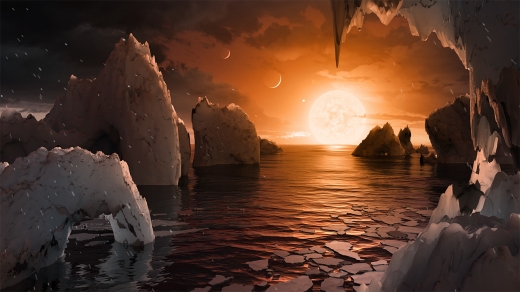
Image: An artist’s conception of the view from the surface of TRAPPIST-1f like this might easily have run as the cover on a 1950s issue of Hans Stefan Santesson’s Fantastic Universe, or maybe one of the large-size Analogs from the early 1960s. Now we’re learning that places like this are really out there. Credit: NASA/JPL-Caltech.
Meanwhile, I can’t help but think in terms of science fiction, and how well the image above would have fit on many a novel dust jacket or magazine cover. From one of these planets, we can look up and see other planets close enough to spot geographical features and cloud patterns. If life emerges on one of these worlds, it can surely move between them, as we know from the presence of so many Martian rocks that have made their way to the Earth. And if a civilization might arise with views like these, what a spur toward the development of technologies to go into space and visit not one but a host of compelling neighbors!
The paper is Guillon et al., “Seven temperate terrestrial planets around the nearby ultracool dwarf star TRAPPIST-1,” Nature 542, 456-460 (23 February 2017). Abstract.

